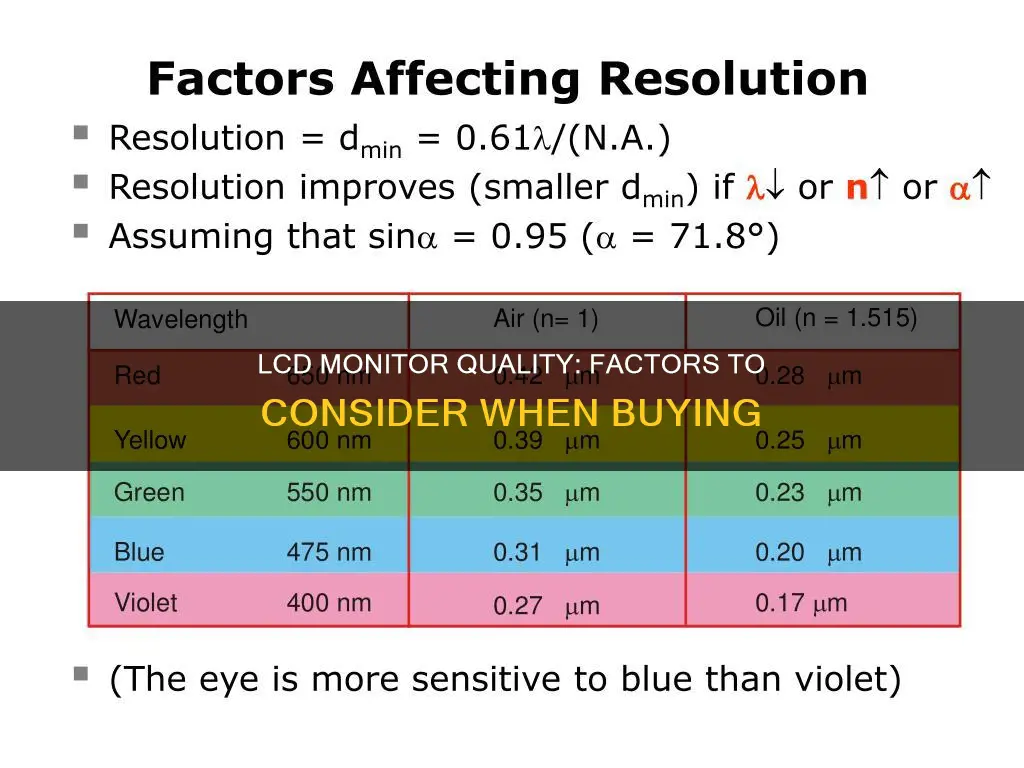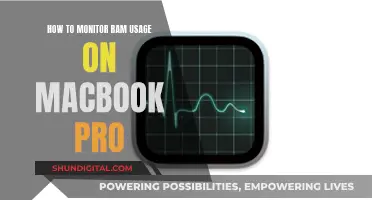
When it comes to LCD monitors, there are several factors that can affect their quality. The most important ones are resolution, response time, brightness, dot pitch, and contrast ratio. Resolution, measured by the number of horizontal and vertical pixels, determines the sharpness of the image. Higher resolutions provide clearer images but can make text harder to read. Response time impacts the speed at which the display can change colours, which is crucial for reducing motion blur in gaming or video playback. Brightness, measured in candelas per square meter (cd/m^2), determines how well the display can adapt to different lighting conditions. Dot pitch refers to the distance between pixels, affecting the sharpness and clarity of the display. Lastly, contrast ratio describes the difference between the brightest white and darkest black, with higher ratios providing a greater range of colours and better overall image quality.
What You'll Learn

Resolution
LCD monitors have only one optimized or native resolution. Using a lower resolution than the native resolution on an LCD monitor can lead to fuzzy images. Therefore, it is crucial to select the right native resolution from the start, as compromising on image quality may be necessary if adjustments are made later.
The resolution of an LCD monitor is also related to its aspect ratio, which describes the relative number of horizontal to vertical pixels. Standard CRT monitors had an aspect ratio of 4:3, resulting in a nearly square display. Today, widescreen monitors are more common, with aspect ratios like 16:9 or 16:10, similar to movie theater screens. A widescreen display is ideal for watching DVDs on your computer without black bars across the screen and for viewing multiple windows simultaneously.
When choosing an LCD monitor, it is essential to consider the desired resolution and aspect ratio, as these characteristics should meet your specific needs. Higher resolutions provide sharper images and more desktop real estate, but they can also make text harder to read. Therefore, it is important to strike a balance between image quality and readability, especially if you have less than perfect eyesight.
LCD HD Monitors: Better Than SyncMaster 2693HM?
You may want to see also

Response time
The response time of an LCD monitor is influenced by the type of panel technology employed. TN (Twisted Nematic) panels, commonly found in budget-friendly monitors, offer exceptionally fast response times, often around 1ms or less. This makes them ideal for fast-paced gaming, especially for competitive first-person shooter games. However, TN panels tend to make compromises in terms of colour accuracy and viewing angles.
On the other hand, IPS (In-Plane Switching) panels are renowned for their superior colour accuracy and wide viewing angles, approaching 180 degrees. While they offer a more immersive visual experience, IPS panels typically have slower response times, usually in the range of 4-8ms. This slight delay can be a crucial factor for intense PvP gaming experiences. Nevertheless, IPS panels are highly favoured by designers and professionals who require precise colour accuracy and the ability to view the screen from various angles.
VA (Vertical Alignment) panels strike a balance between TN and IPS technologies, offering improved colour reproduction and viewing angles compared to TN panels, but not quite reaching the level of IPS. Their response times are generally slower than TN panels but faster than those of IPS.
When considering the response time of an LCD monitor, it's important to remember that while faster response times are generally preferable, especially for gaming, other factors such as colour accuracy, viewing angles, and panel technology should also be taken into account. Additionally, the backlighting technology used in modern LCD monitors, such as LED backlighting, can also impact the overall performance and visual quality of the display.
Degaussing an LCD Monitor: Simple Steps to Success
You may want to see also

Brightness
The brightness of an LCD monitor is an important consideration when choosing a monitor for specific tasks. For example, if you intend to use your monitor for watching movies or playing games, a higher brightness rating of at least 300 cd/m^2 is recommended. This will ensure that the display is clear and bright, even in dark scenes. For office work and browsing, a lower brightness rating of 200-250 cd/m^2 is generally sufficient.
The backlighting technology used in LCD monitors, such as cold cathode fluorescent lamps (CCFLs) or light-emitting diodes (LEDs), can impact the brightness and image quality. CCFLs were commonly used in older LCD monitors, but modern LCD monitors typically use LED backlighting, which provides more consistent and even illumination. LEDs also offer improved brightness control, allowing for more precise adjustments to the screen brightness.
Additionally, some LCD monitors feature local dimming capabilities, which enable dynamic adjustments to the brightness of specific areas of the screen. This results in enhanced contrast and colour accuracy, with deeper blacks and brighter, more vibrant colours. This feature is particularly useful for viewing high dynamic range (HDR) content, as it provides a more immersive visual experience.
It is worth noting that while higher brightness can improve the viewing experience, it may also contribute to eye strain, especially in low-light environments. To mitigate this, some modern monitors include features such as Low Blue Light (LBL) technology, which filters out high-energy, short-wavelength blue light to reduce eye strain and minimise disruption to your Circadian rhythm. Therefore, when considering the brightness of an LCD monitor, it is important to balance image quality with eye comfort and health.
Who Manufactures Acer and Asus Monitors? LG's Involvement Explored
You may want to see also

Dot pitch
Common dot pitches for LCD monitors vary depending on their purpose and price range. High-end monitors for professional applications like graphic design, video editing, and gaming typically have a dot pitch of 0.25 mm, offering extremely detailed and crisp images. A dot pitch of 0.28 mm is common in mid-range monitors, providing a good balance between image quality and cost, making them suitable for general office work, web browsing, and casual gaming. Budget-friendly monitors often have a dot pitch of 0.30 mm or higher, which may be sufficient for basic tasks but may not offer the sharpest image quality.
When selecting the ideal dot pitch for an LCD monitor, several factors should be considered, including the purpose of the monitor, screen size, resolution, budget, and personal preference. For instance, a monitor intended for gaming or video editing may require a lower dot pitch for enhanced image quality and precision, while a monitor for general office work or web browsing might function well with a higher dot pitch. Additionally, larger screens often require a lower dot pitch to maintain image quality and prevent pixelation.
In summary, dot pitch plays a crucial role in determining the quality of an LCD monitor. A lower dot pitch generally indicates a higher-quality display with improved resolution, colour accuracy, and viewing experience. When choosing an LCD monitor, understanding the relationship between dot pitch and image quality can help users make informed decisions based on their specific needs and budget.
Asus Monitor and AMD Radeon RX570: A Perfect Match?
You may want to see also

Contrast ratio
The contrast ratio of an LCD monitor is a key factor in determining its display quality. It is a measure of the difference between the brightest white and the darkest black that the monitor can display. A higher contrast ratio results in whiter whites, blacker blacks, and a greater range of grey values in between. The highest possible contrast ratio is 1,000:1.
It is important to note that contrast ratio values cannot be accurately compared between different manufacturers. Additionally, the term "dynamic contrast" is sometimes used, but it does not represent the same thing as the contrast ratio and can be misleading.
LCD monitors with LED backlighting, particularly those with full-array backlighting, generally offer superior contrast ratios compared to traditional CCFL-backlit LCD monitors. This is because LEDs allow for more precise control over screen brightness and can achieve deeper blacks.
When considering the contrast ratio of an LCD monitor, it is worth noting that this factor may be more or less important depending on the intended use of the monitor. For example, if the monitor is primarily used for office work or web browsing, a lower contrast ratio may be sufficient. However, for watching movies or playing games, a higher contrast ratio will provide a more immersive visual experience.
Furthermore, the viewing angle of an LCD monitor can also impact the perceived contrast ratio. LCDs have a limited viewing angle compared to CRT monitors, so if multiple people will be viewing the monitor from different angles, it is important to consider this factor as well.
Inverters in LCD Monitors: A Universal Feature?
You may want to see also
Frequently asked questions
The quality of an LCD monitor depends on several factors, including resolution, response time, brightness, dot pitch, and contrast ratio. A higher resolution provides a sharper image, while a faster response time reduces motion blur. Higher brightness is better for watching movies or playing games, while a higher contrast ratio results in whiter whites and blacker blacks.
LCD stands for Liquid Crystal Display, and LED stands for Light-Emitting Diode. The main difference lies in their backlighting technology. LCD monitors use cold cathode fluorescent lamps (CCFLs) for backlighting, while LED monitors use light-emitting diodes. LED monitors are thinner, lighter, and more energy-efficient than LCD monitors.
There are three main types of LCD panels: TN (Twisted Nematic), VA (Vertical Alignment), and IPS (In-Plane Switching). TN panels are the most common and offer fast response times, making them ideal for gaming. However, they have poorer colour reproduction and fewer viewing angles. VA panels offer better colour reproduction and viewing angles, while IPS panels provide the best colour accuracy and viewing angles but have slower response times.







